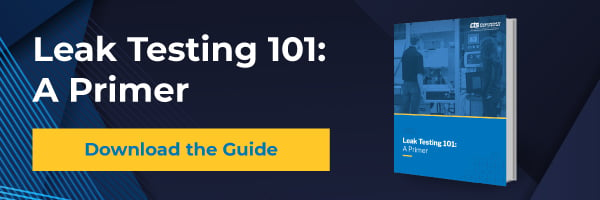5 simple ways to improve your leak test
Leak testing is a common requirement on the production line. It is an important test that ensures the proper functioning of a part or assembly in the field. Due to the importance of this test, it is essential to make sure your test system is always functioning and performing at its best. There is almost always room for improvement at the leak test station which could positively impact your cycle time, product quality, and profitability.
Below, I’ll discuss some simple considerations that could drastically improve your leak test performance.
Optimize your leak test station
A leak test that is reliable, repeatable, and fast enough to keep pace with production begins with how the test part is connected to the test instrument—it comes down to the plumbing, fixturing, seals, and calibration of your leak test station.
Plumbing
Regarding the ‘plumbing’, factors like proximity of the test instrument to the part, as well as hose diameter and materials are important. The closer the part is to the test instrument, the more accurate the leak test and the shorter the test cycle. When choosing your hoses, you want to match the hose’s inner diameter with the fill port to optimize the fill time, and choose a material that won’t deform under pressure. Learn more about how to choose the right plumbing for your leak test station >
Seals & Connectors
Choosing the right seals and connectors is equally important. You want to ensure your seals and connectors are held firmly in place during the entirety of your test cycles to deliver proper performance. Whether a seal is mechanical or pneumatic, your setup should provide feedback to indicate that proper seating pressure and orientation has been achieved before the test cycle begins. This can be accomplished through an electronic sensor (pressure switch), a proximity switch, or a simple travel stop on manually actuated seals. Learn more about choosing the rights seals and connectors >
Controlling Test Pressure
Fluctuating pressure in the air supply line can impact fill time and test accuracy, so you must ensure your test is set up properly to control pressure. Supply pressure must be constantly measured and applied to ensure the required air pressure is maintained for the duration of the test. This is a careful balance, as excessive pressure can accelerate how quickly the seals wear out, affecting your test and maintenance requirements. Learn more about how to control pressure during your leak test >
Ensure your leak testers are calibrated properly
If you rely on leak testing equipment on your line, we recommend regular, annual recalibration to ensure your leak tester is always performing at its best, on every test.
Annual recalibration provides many benefits, including ensuring proper functioning, and ensuring your parts consistently meet desired specifications. Committing to regular calibration also says a lot about your manufacturing quality standards—a testament that any customer or end user will appreciate.
Learn more about the benefits of annual recalibration >
Consider your leak test data
When the physical attributes of the test all seem to be in good shape, your next step could be to look at the data being recorded during your test. Your abilities during this step will vary based on what data and system you have available to you.
Utilizing the basic data collection capabilities of your instrument may at least allow you to analyze indicators of proper, consistent function so that you can have confidence that your test results (pass, fail) are accurate. A more advanced analytics software platform would provide deeper visibility and make it easier to compare historical data and look for trends. For example, using the QualityWorX CTS DataHub turnkey hardware and software solution, our customers are able to access full traceability and a depth of data that enables not only optimization of the leak test, but root cause analysis and continuous improvement.
Learn more about the QualityWorX CTS DataHub and the abilities of advanced leak test analytics >
If you want to learn more about the nuances of leak testing, download our latest guide, Leak Testing 101: A Primer, or contact us with any questions you might have.



